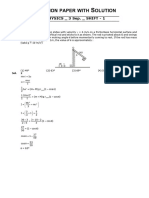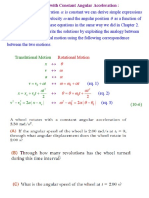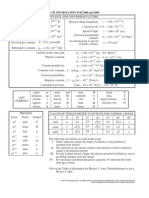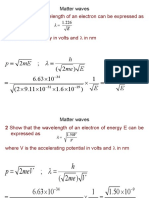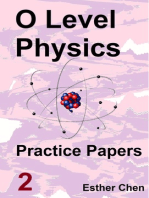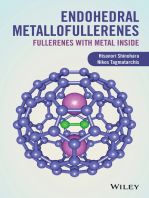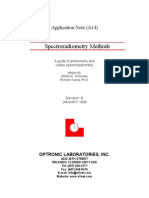Answer
Uploaded by
elynaAnswer
Uploaded by
elynaCHEM 342. Spring 2002. Problem Set #8. Mortimer Chapters 19, 20. Answers.
h h
Note: Please note that B 2 when B is expressed in cm1; and B when
8 cI 8 2 I
B is expressed in Hz.
Rotating Diatomic Molecules
1. For a diatomic molecule in a 1 electronic state, we observe a microwave transition
from J = 1 to J = 2 in the presence of an electric field. How many lines will appear in the
spectrum?
The selection rules for rotational transitions in a 1 electronic state are J 1 and
M J 0,1 , where there are g J 2 J 1 values of M J (i.e. M J 0,1,... J ). The
following transitions are allowed:
J = 1, MJ = +1 to J = 2, MJ = +2, +1, 0
J = 1, MJ = 0 to J = 2, MJ = +1, 0, 1
J = 1, MJ = 1 to J = 2, MJ = 0, 1, 2
This is a total of nine lines.
2. Which of the following diatomic molecules have a rotational microwave spectrum: IF,
O 2 , KCl, Cl 2 .
A pure rotational spectrum will be observed only for those molecules that contain a
permanent dipole moment. Therefore, spectra will be observed only for IF and KCl.
3. Calculate the bond length of 12
C 16O using B 1.9302 cm 1 and the reduced mass
is 1.14 10 26 kg .
h h
B 2
8 cI 8 cR 2
2
h
R 2
8 cB
6.626 10 34 J s
R
8 3.0 10
2 8
m/s 1.14 10 26 kg 193.02 m 1
R 1.13 10 10 m
Vibrating Diatomic Molecules
4. Which of the following vibrational transitions will be observed for a diatomic molecule
(treated as a harmonic oscillator): v = 1 to v = 3; v = 2 to v = 3; v = 5 to v = 4.
The selection rules for vibrational translations is v 1 . Therefore, the allowed
transitions are v = 2 to v = 3; and v = 5 to v = 4.
5. Calculate the frequency of the J = 3 to J = 4 transition in the pure rotational absorption
spectrum of 14 N 16 O . The equilibrium bond length is 115 pm. Assume no centrifugal distortion.
CHEM 342. Spring 2002. Problem Set #8. Mortimer Chapters 19, 20. Answers.
The mass of a nitrogen atom is 14.003 amu; the mass of an oxygen atom is 15.995 amu; and the
conversion factor is 1.6605 10 27 kg/amu .
m N mO 2
I R 2 R
m N mO
14.003 amu 15.995 amu
I
1.6605 10 27 kg/amu 1.15 10 10 m 2
14.003 amu 15.995 amu
I 1.64 10 46 kg m 2
h
B
8 2 cI
6.626 10 34 J s
B 170.6 m 1 1.706 cm 1
8 3.0 10
2 8
m/s1.64 10 46
kg m 2
The frequency is
2 B c J 1
2 1.706 cm 1 3.0 10 8 m/s 3 1 4.09 1011 s 1
Rotation of Polyatomic Molecules
6. Identify the molecules that will exhibit a pure rotational absorption microwave
spectrum: N 2 O, NO 2 , CClF3 , NF3 , SF6 , CH 4 , CO2 .
The molecules that have a permanent dipole moment will have a rotational spectrum:
N 2 O, NO 2 , CClF3 , NF3 .
7. What information about the molecular geometry for N 2 O can be determined from
knowing that a pure rotational absorption spectrum is observed for this molecule?
There are four possible arrangements for the atoms in N 2 O : linear N-N-O; linear N-O-
N; bent N-N-O; and bent N-O-N. The linear N-O-N hypothesis can be eliminated as a possibility
because this molecule would not have a permanent dipole moment and would not exhibit a pure
rotational spectrum.
8. The moment of inertia about an axis perpendicular to the principal axis ( I ) for NH 3
is 2.82 10 47 kg m 2 . There are different types of rigid rotors: linear, spherical top, prolate
symmetric top, oblate symmetric top, asymmetric top. Which type of rotor is NH 3 ? Calculate
the separation (expressed in cm 1 ) of the pure rotational spectrum lines for NH 3 . Hint: The
moment of inertia about the principal axis is given by I ll 2m H R 2 1 cos , where the mass of
a hydrogen atom = mH = 1.6735 10 27 kg ; the N-H bond length = R = 1.014 10 10 m ; and
the bond angle is 106.78. The moment of inertia about the principal axis is I ll .
In order to determine if NH 3 is an oblate or a prolate symmetric rotor, we need to
compare I and I ll (the moment of inertia about the principal axis).
CHEM 342. Spring 2002. Problem Set #8. Mortimer Chapters 19, 20. Answers.
I ll 2m H R 2 1 cos
I ll 2 1.6735 10 27 kg 1.014 10 10 m 2
1 cos 106.78
47 2
I ll 4.435 10 kg m
I ll is greater than I (which equals 2.82 10 47 kg m 2 ). Therefore, NH 3 is an oblate
symmetric top.
h
B 2
8 cI
6.626 10 34 J s
B 992 m 1 9.92 cm 1
8 3.0 10
2 8
m/s 2.82 10 47
kg m 2
The rotational line separations are
2 B J 1 2 B J 2 B 2 9.92 cm 1 19.8 cm 1
9. The molecule CClF3 is a prolate symmetrical top with A 0.1908 cm 1 and
B 0.1111 cm 1 . Calculate the energy corresponding to J = 2 and K = 1.
E J , K J J 1 B hc K 2 A B hc
E J , K 2 2 1 0.1111 cm 1 1 2 0.1908 cm 1 0.1111 cm 1 100 cm/m 6.63 10 34 J s 3.0 10 8 m/s
E J , K 1.48 10 23 Joules
Vibration of Polyatomic Molecules
10. Consider the vibrational mode that corresponds to the uniform expansion of the
benzene ring. Is it infrared active?
This vibration does not change the molecular dipole moment. Therefore, the mode is
infrared inactive.
Raman Spectroscopy
11. Explain the difference between Stokes and anti-Stokes lines in Raman Spectroscopy.
Anti-Stokes lines correspond to transitions from higher to lower energy levels. In this
case, the molecule makes a transition with J 2 and the scattered photon emerges with
increased energy (and therefore higher frequency than the incident radiation).
Spectral lines corresponding to transitions from a lower to a higher molecular energy
levels are Stokes lines. The molecules makes a transition with J 2 and the lines appear at
lower frequency than the incident radiation.
You might also like
- Christina Latorre - Redshift Simulator Activity Sheet VirtualNo ratings yetChristina Latorre - Redshift Simulator Activity Sheet Virtual3 pages
- Fundamentals of Physics Extended 10th Edition Halliday Solutions Manual PDF Download Full Book with All Chapters100% (3)Fundamentals of Physics Extended 10th Edition Halliday Solutions Manual PDF Download Full Book with All Chapters52 pages
- Fundamentals of Physics Extended 10th Edition Halliday Solutions Manual instant download100% (2)Fundamentals of Physics Extended 10th Edition Halliday Solutions Manual instant download68 pages
- Access the entire Fundamentals of Physics Extended 10th Edition Halliday Solutions Manual instantly with a one-click PDF download.100% (2)Access the entire Fundamentals of Physics Extended 10th Edition Halliday Solutions Manual instantly with a one-click PDF download.47 pages
- Solucionario Capitulo 22 Paul e TippensNo ratings yetSolucionario Capitulo 22 Paul e Tippens16 pages
- Immediate download Fundamentals of Physics Extended 10th Edition Halliday Solutions Manual all chapters100% (3)Immediate download Fundamentals of Physics Extended 10th Edition Halliday Solutions Manual all chapters70 pages
- Atomic Structure: Chapter Practice ProblemsNo ratings yetAtomic Structure: Chapter Practice Problems2 pages
- Fundamentals of Physics Extended 10th Edition Halliday Solutions Manual instant download100% (1)Fundamentals of Physics Extended 10th Edition Halliday Solutions Manual instant download58 pages
- Fundamentals of Physics Extended 10th Edition Halliday Solutions Manualinstant download100% (1)Fundamentals of Physics Extended 10th Edition Halliday Solutions Manualinstant download61 pages
- Worksheet - Mass Equivalent of Energy KeyNo ratings yetWorksheet - Mass Equivalent of Energy Key4 pages
- PHYSICS FOR MECHANICAL ENGINEERING 1 MID SEM 1 November 01 2023No ratings yetPHYSICS FOR MECHANICAL ENGINEERING 1 MID SEM 1 November 01 20232 pages
- 14_Most_Difficult_MCQsNCERT_based_from_3_Papers_of_NEET_2015_&_NEETNo ratings yet14_Most_Difficult_MCQsNCERT_based_from_3_Papers_of_NEET_2015_&_NEET3 pages
- H P Me Mee E E: 1 Show That The Wavelength of An Electron Can Be Expressed AsNo ratings yetH P Me Mee E E: 1 Show That The Wavelength of An Electron Can Be Expressed As32 pages
- Chem 340 Hw2 Key 2011 Physical Chemistry For Biochemists 1No ratings yetChem 340 Hw2 Key 2011 Physical Chemistry For Biochemists 17 pages
- Chem Principles 7e ISM Focus 01 Even FINALNo ratings yetChem Principles 7e ISM Focus 01 Even FINAL26 pages
- Spectroscopy: Microwave (Rotational) Infrared (Vibrational) Raman (Rotational & Vibrational) TextsNo ratings yetSpectroscopy: Microwave (Rotational) Infrared (Vibrational) Raman (Rotational & Vibrational) Texts33 pages
- Electron Beam-Specimen Interactions and Simulation Methods in MicroscopyFrom EverandElectron Beam-Specimen Interactions and Simulation Methods in MicroscopyNo ratings yet
- An Introduction to Synchrotron Radiation: Techniques and ApplicationsFrom EverandAn Introduction to Synchrotron Radiation: Techniques and ApplicationsNo ratings yet
- Endohedral Metallofullerenes: Fullerenes with Metal InsideFrom EverandEndohedral Metallofullerenes: Fullerenes with Metal InsideNo ratings yet
- Essentials of Radiographic Physics and Imaging 1st Edition Johnston Test Bank - All Chapters Are Available In PDF Format For Download100% (1)Essentials of Radiographic Physics and Imaging 1st Edition Johnston Test Bank - All Chapters Are Available In PDF Format For Download51 pages
- CHEM1111 Tutorial 3 - Answers To Critical Thinking Questions Model 1: Electron EnergyNo ratings yetCHEM1111 Tutorial 3 - Answers To Critical Thinking Questions Model 1: Electron Energy3 pages
- June 2012 QP - Paper 1P Edexcel Physics IGCSENo ratings yetJune 2012 QP - Paper 1P Edexcel Physics IGCSE36 pages
- Temperature-Aware Routing Protocol For Intrabody NanonetworksNo ratings yetTemperature-Aware Routing Protocol For Intrabody Nanonetworks7 pages
- Radiation protection A guide for scientists regulators and physicians 4ed Edition Shapiro J. download100% (2)Radiation protection A guide for scientists regulators and physicians 4ed Edition Shapiro J. download50 pages
- Colorimeter and Fully Auto Analyzer - Group H100% (1)Colorimeter and Fully Auto Analyzer - Group H35 pages
- Green Photocatalysts Mu. Naushad - The latest ebook edition with all chapters is now available100% (3)Green Photocatalysts Mu. Naushad - The latest ebook edition with all chapters is now available57 pages
- Chapter 4 - Refraction of Light at Plane Surfaces - Selina Solutions Concise Physics Class 10 ICSENo ratings yetChapter 4 - Refraction of Light at Plane Surfaces - Selina Solutions Concise Physics Class 10 ICSE94 pages
- Module 4 - Energy Transfer (Student Guide)No ratings yetModule 4 - Energy Transfer (Student Guide)11 pages
- Nmat Physics 2 (M-1 Exercises) DIRECTIONS: Select The Best Answer To Each of TheNo ratings yetNmat Physics 2 (M-1 Exercises) DIRECTIONS: Select The Best Answer To Each of The1 page
- 6.453 Quantum Optical Communication Jeffrey H. Shapiro: 6.453 - Lecture 22No ratings yet6.453 Quantum Optical Communication Jeffrey H. Shapiro: 6.453 - Lecture 226 pages






















